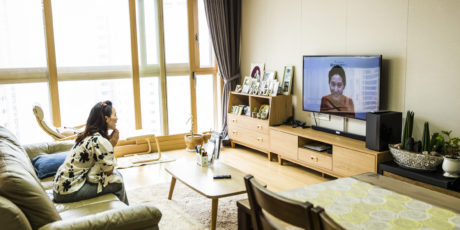
The new sales word – part 3: empowering your employees
When you think about what makes a good employer, it’s often less about the work environment and more about the feeling you get from working for them. As we move into an era where home and hybrid working is the norm (a shift I explored in the second part of this series), that feeling will have an even bigger influence on employee wellbeing. And it stems, in part, from a red thread that connects everything an organisation does to its core values.
That red thread can help to create a shared sense of purpose for colleagues who rarely meet in person. It ensures teams still feel like teams, even if each member is working from home individually. And it can alleviate some of the loneliness and isolation that people might be feeling right now. Because make no mistake: home-working can be tough if you don’t feel your work has meaning.
It’s equally tough if you don’t have the time and the space to perform at your best. Just put yourself in the shoes of someone who’s struggling to balance work with childcare for a second. Or a junior sales colleague who’s trying to do their job from a tiny bedroom in a shared house. It’s hard to be at the top of your game in these situations. But that’s the new normal for many people – and rather than asking for help they may be putting a brave face on things. So what can business leaders do to make their lives easier?
To be honest, I don’t have all the answers. But I’ve certainly seen the benefit of scheduling regular video check-ins with your team and spending one-on-one time with people who seem to be finding things a bit tough. In fact, sometimes all it takes to make someone feel valued is a quick message to say thank you.
This kind of regular communication with your teams is a whole lot easier with an all-in-one collaboration platform like Webex. Our noise-cancelling headsets can also help people in business households to remain productive, and our desk devices mean people who spend a lot of time in video meetings won’t have to spend every day hunched over a laptop.
In fact, ergonomics is fast becoming a big issue for remote workers, many of whom are perched on kitchen chairs at makeshift desks. And just think how often people popped out for lunch or a coffee while working in the office. They were never just in one environment all day, and nor should they be now.
That’s why I often suggest that colleagues take a walk outside if we’re catching up on the phone, just to combat that sense of staring at the same four walls day in, day out. I also encourage my team members to pick and pad and pen from time to time and, if possible, work outside for a while.
Giving your team an afternoon off here and there can help to stop people from burning out while working from home. Because while there are numerous advantages to video conferencing, it seems to take a heavier cognitive toll than in-person meetings. Don’t forget that many people who used the journey home from work as a chance to decompress no longer have that option either. Granted, there are plenty of people who won’t miss the commute in the slightest. But for others, it offered a chance to read a book and unwind at the end of a long working day – as well as a clear delineation between “work” and “home”.
Some forward-thinking businesses are already taking steps to address the issue of burnout. Salesforce, which has given all employees the option to work from home until at least July 31 next year, have expanded their family care leave, with parents eligible for six weeks of paid time off. It’s the kind of smart thinking that shows how companies can get ahead of the curve on issues that might cause problems for their employees. And it also shows they empathise with the struggles their people are facing.
In an ideal world, every business – and indeed business leader – would aim to show this kind of empathy. But some still seem to believe that simply being employed in these difficult times should make people feel happy. That runs counter to Maslow’s hierarchy of needs, which has three further levels above safety, the level employment falls under: love/belonging, esteem and self-actualisation. So if you don’t make people feel they’re a valuable part of your organisation, they may leave and seek employment with a company that does.
Training opportunities are one way of reassuring people that you’re keen to invest in them and their future. Team members who’ve been used to working a certain way for most of their career may need extra help to adapt to the working environment we find ourselves in today. At the other end of the spectrum, colleagues who’re still in the early stages of their career may need more training to progress in a world where office-based interactions and support are more infrequent.
In addition, your sales teams may not fully understand how to get the most out of customer interactions now that most communication is virtual rather than in-person. So while Webex can provide them with all the tools they need to collaborate effectively, without proper training and support they may fail to use them as effectively as they could.
Ultimately, businesses of all shapes and sizes need to make people feel that their home working environment isn’t their “COVID workspace”, but rather their next workspace. Webex is helping millions of businesses to navigate this transformational change. We understand that pressures people are under today are ultimately pressures they’ve never been under before. But we also know that with the right support and a red thread that ties their work to the purpose of the business, they won’t feel imprisoned by homeworking. They’ll feel empowered by it.
To find out more about Webex and sign-up for a free 90-day trial, visit: www.cisco.com/c/en_uk/solutions/collaboration/webex-free-trial.html
Tags:


